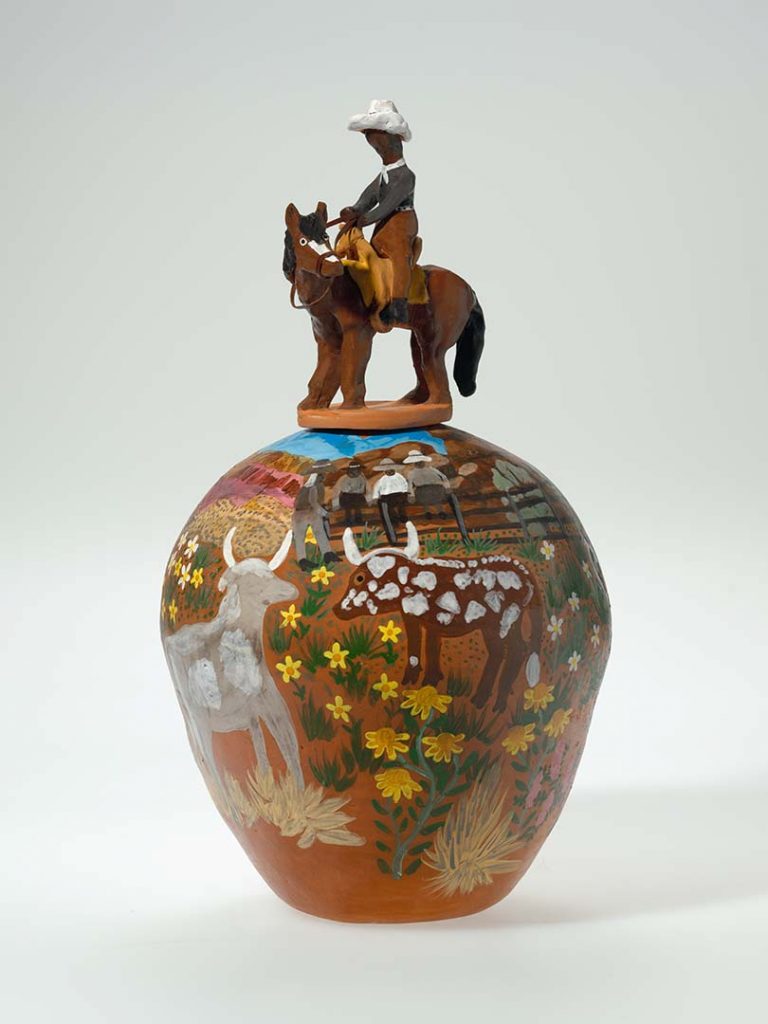We acknowledge the Traditional Owners of the land on which the Queensland Art Gallery | Gallery of Modern Art stands and recognise the creative contribution First Australians make to the art and culture of this country.

Irene Mbitjana Entata / Potter / Arrernte/Luritja peoples / Australia 1946–2014 / Hermannsburg Potters / Pottery workshop / Australia est. 1990 / Albert Namatjira droving 2001 / Earthenware, hand-built terracotta clay with underglaze colours and applied decoration, leather / 53 x 36cm (diam.) (complete) / Purchased 2019. Queensland Art Gallery | Gallery of Modern Art Foundation / Collection: Queensland Art Gallery | Gallery of Modern Art / © Irene Mbitjana Entata/Copyright Agency 2021.
Irene Mbitjana EntataAlbert Namatjira droving 2001
Not Currently on Display
This earthenware vessel is one of three by Irene Entata that chronicle the life of the great Arrernte artist Albert Namatjira. Entata was among the most senior members of the Hermannsburg Potters and remembered seeing Albert and his sons painting.1 Entata’s works most often featured historical memories of what she called the ‘Mission Days’, when Hermannsburg was run by strict Lutheran Missionaries. Although many recall the strictness and harsh conditions enforced by the missionaries, older Aboriginal Christians, Entata included, reminisce fondly for a time they saw as giving a sense of structure and purpose to the lives of local people and greater social cohesion to the community more broadly.
Albert Namatjira droving depicts a young Albert droving cattle around Gilbert Spring, a water site at the base of the Krichauff Ranges, west of Ntaria (Hermannsburg) and south of Tnorala (Gosses Bluff). Here the wildflowers grow abundantly in season and food is in good supply for the cattle. Across Australia Aboriginal men were heavily involved in the cattle industry, many boys were sent out to work as drovers and stock hands from the age of 14 and their skills as a drover became a source of pride for many Aboriginal men. Here, Albert is pictured among other Aboriginal men droving cattle and sitting yarning atop cattle yard fences surrounded by their Arrernte country in bloom.
Endnotes:
1. Artist’s statement in Jennifer Isaacs, Hermannsburg Potters: Aranda artists of central Australia, Craftsman House, Sydney, 2000, p.100.
Irene Mbitjana Entata is regarded as one of the foremost potters in the Hermannsburg School. She was born at Hermannsburg in 1946 to Rolf Entata, a Luritja/Western Arrernte man, and Millicent Entata, a Walpiri/Luritja woman from Wynparrka. She attended school at Hermannsburg where she did some drawing and plasticine modelling, and recalls watching Albert Namitjira painting.
She first began making pots at Tjamankura with her sister Virginia Rontji in 1990 and became a foundation member of the Hermannsburg Potters. Typically, Hermannsburg pots use the most ancient of pottery techniques, coil-building, and are then smoothed into shape. Irene Entata was a highly dedicated potter and talented animal modeller. Some of the themes she used on her pots were native Australian animals, such as bats, bilbies, ducks, emus, geckos, lizards, mice, parrots, quolls and skinks; introduced animals, such as goats, rabbits, pigs, camels and sheep; exotic animals, such as elephants, reindeers, polar bears, dinosaurs and tropical fish; and native plants including wild blackberries, yams, bush raisins, bush oranges and bush bananas.1 She also painted distinctive landscapes using bold colours with black outlining.
Endnotes:
1. Biography based on ‘Hermannsburg potters: now we are working in clay’. MAGNT, Darwin, 1996, unpaginated.